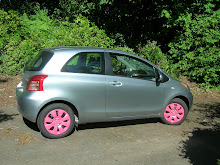
I have taken nearly every form of transportation possible in India, and each has been an eye-opening experience. A few words on getting around:
Bicycles
The high price of gas petrol along with the massive size of campus makes bicycles a popular choice and a necessity for the University of Hyderabad student. There appear to be a lot of large corporate monopolies in India and so even with a few thousand bikes on campus, it is a few thousand of the same crappy, one-speed bicycle in a few different colors. They are only differentiated by the varying states of disrepair and customized bike seats. My bike (the piece of junk on the left there) and I have a very hostile relationship; I’d rather not talk about it.
Buses
Traveling farther afield from campus usually requires a bus ride. I believe I described Indian public buses before as a “big, sweaty, group-hug with a lot of strangers.” This remains true. Luckily, buses have two separate entrances in the front and the back, the front being for women and the back for men. The seats are divided in the same way with the front section reserved for ladies. The men’s section is usually much more crowded and as a lady I can usually get one of the coveted front seats, although, having a seat sometimes means you get to have a tired old woman or someone else’s child sitting on your lap for the duration of your 8 cent journey.
Rickshaws
You must haggle your price with your rickshaw driver before you get in. The meter is always “broken.” 100% of Rickshaw drivers are 100% crazy. Your rickshaw driver may stop at any point to buy himself a snack or to ask a stranger for directions to your desired destination. The inside of your rickshaw will, generally, be decorated with pictures of Bollywood stars, and if you're lucky the driver will deafen you with loud Bollywood music as you drive.
Trains
Indian trains are a cheap and decent way to travel long distances, but they move inexplicably slowly and they bear no resemblance to the trains in The Darjeeling Limited. The sleeper cars have three-tier 
Planes
Indian planes are relatively cheap and relatively luxurious. A recent flight I was on began with the flight attendants distributing a small mango juice-box to each passenger. I had been in India long enough at this point for this to seem unsurprising, but when I took time to remove myself from the situation I realized how bizarre I would think it was if I was given a box of mango juice on an American airline. Even one-hour flights in India will serve a meal. You will be given the options of Veg. or Non-Veg. which usually consists of rice, daal, a curry, a salad and a dessert. It is by far the best plane food I have ever eaten…as in…it is actually good food, food I would pay to eat. I tried explaining the lukewarm, rubbery, inedible food found on American planes to an Indian friend and he really didn’t seem to understand where I was coming from.
The streets of Hyderabad are filled, not with cars, but primarily with trucks, rickshaws, and motorcycles. The concept of seating and towing capacities for each of these modes of transportation is stretched to its limits. A truck may move a pile of raw materials twice its own size, a four-seat rickshaw can hold at least eleven people, and a motorcycle is a family vehicle. Because trucks are generally loaded sky-high with goods, rickshaws have no back windows, and motorcycles are generally not equipped with mirrors, no one speeding down the road has any rear-view vision. The problem is solved by constant noise-making. As any moving vehicle approaches any other moving vehicle, the drivers create as much obnoxious honking as possible. The backs of most trucks and buses read “Sound Horn!” or “Horn OK Please!” in colorful letters. The streets of Hyderabad are very noisy. Luckily, many cars and buses are outfitted with vanity horns that play bits of music when they honk. Even better than the musical horns is the “back up music” that most motorized vehicles have. I believe this also has to do with heavy tr
Drive safe.





an Indian friend, eh? ;)
ReplyDelete"Drive safely" Safely, not safe.
ReplyDeleteYour bike is the "emerald hero" that's a cool name for a bike.
Loved the blog. You are so observant of the cultural differences. Ignore Nicole, after that long blog I'll forgive you for the adverb error.
ReplyDeleteAre those Foster Grants you have on? How chic!
ReplyDelete